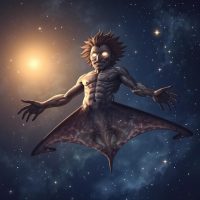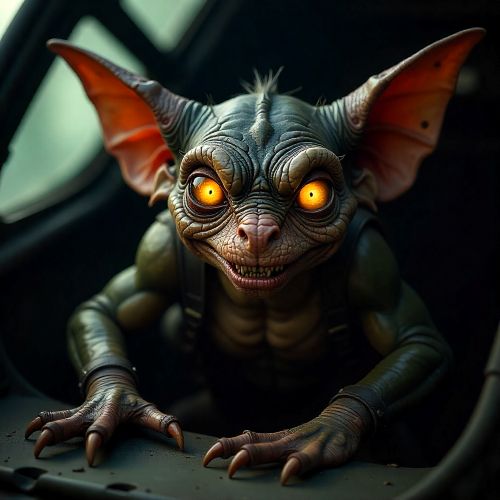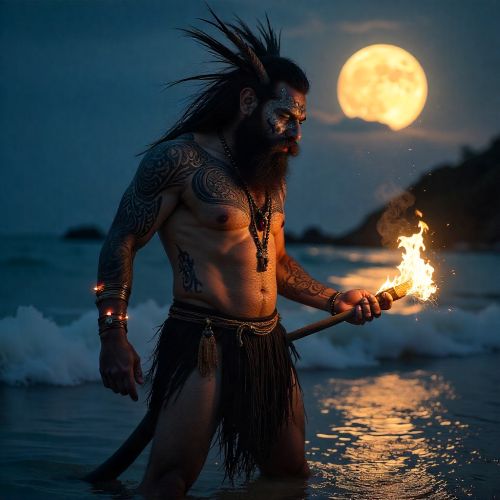Aluluei : God of Navigation
Listen
Aluluei
Introduction
Aluluei is one of the most important deities in the mythology of the Ifaluk people, an indigenous community of the Caroline Islands in Micronesia. Known as the god of navigation and direction, Aluluei symbolizes the intimate bond between the islanders and the vast Pacific Ocean. His legend reflects the deep understanding of the stars, waves, and winds that define Micronesian seafaring traditions. Aluluei’s divine wisdom was inherited from his father, Pälülop, the revered god of canoes and maritime mastery. Together, their stories form the foundation of Ifaluk cosmology, where the sea is not merely a landscape but a living, spiritual entity. Aluluei stands as a divine navigator who connects the heavens and the ocean, embodying both human ingenuity and celestial guidance.
Physical Traits
Descriptions of Aluluei’s appearance are rich in symbolism rather than physical detail. He is often portrayed as having two faces—one looking forward and one backward—representing his ability to see all directions and guide sailors safely through the uncertain seas. This duality symbolizes foresight and awareness, essential traits for those who traverse the open ocean. In some oral traditions, Aluluei’s upper body is human while his lower half takes the form of a stingray, an animal that glides silently through the water. The stingray imagery connects him directly to the sea, emphasizing agility, grace, and adaptability—qualities revered by seafarers. His colors—red, black, and white—carry sacred significance across Micronesian culture, denoting life, protection, and balance. Legends also tell that when Aluluei was transformed into a celestial being, his countless eyes became stars in the night sky, forever guiding sailors toward their destinations.
Family
Aluluei’s divine lineage traces back to Pälülop, a powerful god associated with boats, navigation, and mastery of the sea. Pälülop, in turn, is considered a descendant of the supreme deity Usin, linking Aluluei to the highest cosmic order in Micronesian belief. The relationship between father and son symbolizes the transmission of knowledge—specifically, the sacred art of navigation—from one generation to another. However, Aluluei’s story is also marked by conflict. In some accounts, he was betrayed and killed by his jealous brothers, Big Rong and Little Rong. His death and subsequent resurrection by his father transformed him into a spirit of light, with his many eyes becoming the stars that guide seafarers. This transformation from mortality to divinity encapsulates the Micronesian belief in renewal and the cyclical nature of existence, where death leads to new life and purpose.
Other names
While “Aluluei” is the name most commonly used on Ifaluk, variations exist across the Micronesian islands. The deity is sometimes referred to as “Ialuluwe” or “the two-faced navigator,” depending on local dialects and storytelling traditions. His father’s name, too, appears in multiple forms—Pälülop, Paluelap, or Palulop—reflecting the diversity of linguistic expression among the Caroline Islands. In related mythologies, parallel figures such as Rulop of Yap and Rulud of Palau share similar attributes, highlighting the cultural interconnectedness of Micronesia. These variations demonstrate how oral storytelling evolved independently across island groups while preserving shared spiritual themes of guidance, cosmic order, and seafaring wisdom.
Powers and Abilities
Aluluei’s powers encompass mastery of navigation, divine perception, and protection over voyagers. His most significant gift is his command over celestial navigation. After his transformation, his numerous eyes became the stars, enabling sailors to orient themselves across vast oceanic distances. Through this divine act, Aluluei not only became part of the sky but also a living map for generations of navigators. His two faces grant him the power to see in all directions simultaneously, representing omniscience and constant vigilance—traits vital for survival at sea.
Beyond navigation, Aluluei serves as a spiritual protector, watching over sailors during perilous journeys. When storms arise or waves grow violent, sailors invoke his name to calm the seas. His stingray form symbolizes his ability to move fluidly through both physical and spiritual realms, guiding travelers through danger and uncertainty. He is also seen as a teacher who imparts wisdom about balance and respect for nature. The sea, in Aluluei’s philosophy, is not to be conquered but understood and harmonized with—a principle deeply rooted in Micronesian environmental ethics.
Modern Day Influence
In modern Micronesian society, Aluluei remains a powerful symbol of cultural identity and ancestral wisdom. On Ifaluk and neighboring islands, traditional navigation is still practiced using ancient methods that rely on the stars, wind, and ocean currents. These techniques, once passed down orally, are now being documented and taught through educational programs that honor Aluluei as the divine origin of this knowledge. His story reinforces the belief that the stars are not just distant lights but living spirits that guide and protect.
Art, storytelling, and ritual performances across Micronesia continue to celebrate Aluluei’s legacy. His image, often depicted with two faces or a stingray tail, appears in carvings, tattoos, and modern artworks that pay homage to the islanders’ maritime past. In academic circles, Aluluei’s myth is studied as part of broader research into Pacific navigation and cosmology, offering valuable insight into how indigenous cultures developed complex systems of orientation long before Western exploration.
Environmental and cultural activists in Micronesia also invoke Aluluei’s name as a symbol of ecological balance. His myth underscores the importance of harmony between humanity and nature—a message increasingly relevant in the context of rising sea levels and environmental change threatening island communities. Through festivals and oral recitations, Aluluei’s story continues to inspire younger generations to preserve their heritage and reconnect with ancestral practices.
Today, Aluluei represents more than an ancient god; he is a living embodiment of the Micronesian spirit—curious, resilient, and in tune with the cosmos. His myth bridges the ancient and the modern, reminding people that the wisdom of the past still shines in the stars that guide them across the ocean’s endless expanse.
Related Images
Source
Allen, P. J., & Saunders, C. (2019). ALULUEI – the Ifaluk God of Direction (Micronesian Mythology). Godchecker. https://www.godchecker.com/micronesian-mythology/ALULUEI/
Encyclopedia.com. (2025, October 24). Micronesian Mythology. https://www.encyclopedia.com/humanities/news-wires-white-papers-and-books/micronesian-mythology
Burrows, E., & Spiro, M. E. (1957). Sharing and Ethics in Ifaluk Culture. [Referenced in Micronesian anthropological studies].
Spiro, M. E. (1951). Some Ifaluk Myths and Folk Tales. Journal of the Polynesian Society. https://www.jstor.org/stable/536156
Cantova, J. (1728). Historical Accounts of Ifaluk Island Culture. [Historical manuscript cited in anthropological reviews].
Pantheon.org. (n.d.). Alulue | Facts, Information, and Mythology. https://pantheon.org/articles/a/alulue.html
World Mythos. (2024, December 22). Micronesian Mythology Archives. https://worldmythos.com/micronesian-mythology/
Occult World. (n.d.). Aluluei: Micronesian Mythology. https://occult-world.com/aluluei/
Rainbird, P. (2004). The Archaeology of Micronesia. Cambridge University Press.
Gladwin, T. (1970). East is a Big Bird: Navigation and Logic on Puluwat Atoll. Harvard University Press.
Lewis, D. (1994). We, the Navigators: The Ancient Art of Landfinding in the Pacific. University of Hawaii Press.
Alkire, W. H. (1978). Coral Islanders. University of Massachusetts Press.
Feinberg, R. (1995). Polynesian Seafaring and Navigation: Ocean Travel in Anutan Culture and Society. Kent State University Press.
Frequently Asked Questions
What is lorem Ipsum?
I am text block. Click edit button to change this text. Lorem ipsum dolor sit amet, consectetur adipiscing elit. Ut elit tellus, luctus nec ullamcorper mattis, pulvinar dapibus leo.
What is lorem Ipsum?
I am text block. Click edit button to change this text. Lorem ipsum dolor sit amet, consectetur adipiscing elit. Ut elit tellus, luctus nec ullamcorper mattis, pulvinar dapibus leo.
What is lorem Ipsum?
I am text block. Click edit button to change this text. Lorem ipsum dolor sit amet, consectetur adipiscing elit. Ut elit tellus, luctus nec ullamcorper mattis, pulvinar dapibus leo.
What is lorem Ipsum?
I am text block. Click edit button to change this text. Lorem ipsum dolor sit amet, consectetur adipiscing elit. Ut elit tellus, luctus nec ullamcorper mattis, pulvinar dapibus leo.
What is lorem Ipsum?
I am text block. Click edit button to change this text. Lorem ipsum dolor sit amet, consectetur adipiscing elit. Ut elit tellus, luctus nec ullamcorper mattis, pulvinar dapibus leo.






